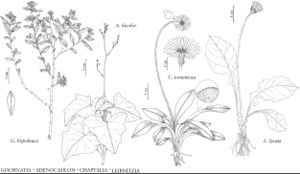Difference between revisions of "Chaptalia tomentosa"
Descr. Pl. Nouv., plate 61. 1802.
Common names: Woolly sunbonnet
FNA>Volume Importer |
FNA>Volume Importer |
(No difference)
| |
Revision as of 18:36, 24 September 2019
Leaves sessile; blades elliptic to elliptic-obovate, 5–18(–24) cm, margins denticulate, abaxial faces densely white-tomentose, adaxial faces green, glabrous or glabrate. Heads nodding in bud and fruit, erect in flowering. Peduncles ebracteate, 5–20 cm at flowering, 25–40 cm in fruit, not dilated distally. Florets: outer pistillate, corollas creamy white (with purple, abaxial midstripe), laminae 0.9–1.5 mm wide; inner florets functionally staminate. Cypselae 3.8–5.1 mm, beaks stout, lengths 0.2–0.25 times bodies, faces (bodies only) glabrous, beaks hairy (hairs spreading-ascending, swollen-apiculate). 2n = 48.
Phenology: Flowering Dec–Apr(–May in North Carolina).
Habitat: Coastal plain pinelands, sandy soils in grass-sedge bogs, along ditches, open areas, thin woods
Elevation: 0–50 m
Distribution

Ala., Fla., Ga., La., Miss., N.C., S.C., Tex.
Discussion
Selected References
None.
Lower Taxa
None.
